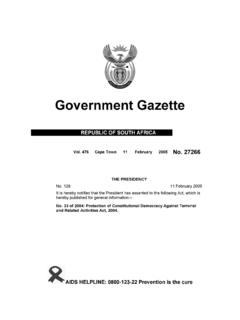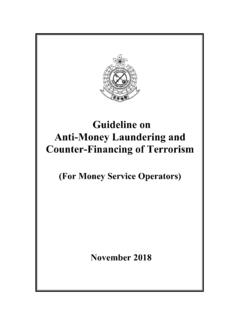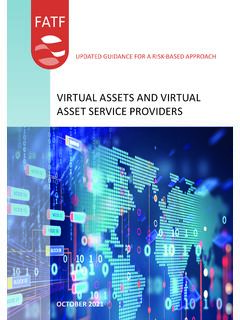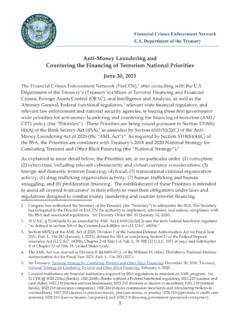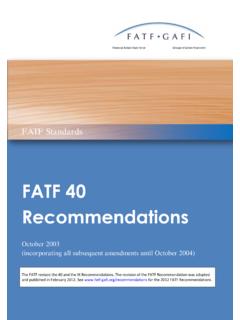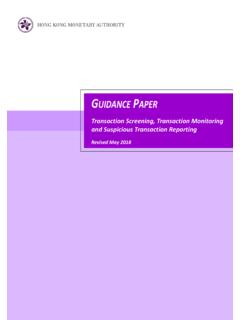Transcription of A NEW APPROACH TO COMBAT MONEY LAUNDERING AND …
1 1 A NEW APPROACH TO COMBAT MONEY LAUNDERING AND TERRORIST financing 13 June 2017 1. INTRODUCTION Following the enactment of the Financial Intelligence Centre Amendment Act, No 1 of 2017 (Amendment Act) published in the Government Gazette on 2 May 2017, the Minister of Finance has on 13 June 2017 gazetted (Gazette No 40916) the dates for the coming into operation of various sections in the Amendment Act, together with a Roadmap. Draft Regulations, Draft Withdrawal of Exemptions and Draft Guidance are also published this week to invite comments from key stakeholders and members of the public.
2 The Financial Intelligence Centre Act, 2001 (FIC Act) has since 2003 been the key regulatory tool to protect the integrity of the South African financial system against abuse for illicit purposes like MONEY LAUNDERING the proceeds of crime and the financing of terrorism. The Amendment Act strengthens the FIC Act by introducing a risk-based APPROACH to customer due diligence, among others. It puts the riskbased APPROACH at the centre of South Africa s AML/CFT regime and recognises that the risks of MONEY LAUNDERING and terrorist financing vary within and between sectors.
3 It requires an understanding of MONEY LAUNDERING and terrorist financing risks at various levels including within Government, supervisors and institutions in private sector. The risk-based APPROACH incorporates three key elements: a) Strengthening AML/CFT through a more consultative APPROACH based on partnerships between key stakeholders in both the public and private sectors; b) Improving co-ordination and collaboration to ensure more effective preventive measures and better enforcement measures ; and c) More customer-friendly and less-costly APPROACH to implementation of AML/CTF in line with the Treat Customers Fairly initiative.
4 The RBA is intended to offer a better, more cost-effective alternative, to the prescriptive tick box APPROACH , enabling accountable institutions to spend more time only on customers assessed to be risky in order to meet compliance requirements more efficiently. The purpose of the new provisions introduced in the FIC Act is, among others, to enhance the transparency in the financial system, based on robust customer due diligence measures, so that it can be easily established who is doing business with financial and non-financial institutions and what the nature of that business is.
5 This is made possible if adequate information is captured in the records of financial (and other accountable) institutions to support any subsequent investigation of MONEY LAUNDERING and terrorist financing . Simply put, this means that institutions in the financial system are dealing with known customers who are conducting legitimate business, and that they are able to spot when customers are conducting business that may be of an illicit nature and report that to the correct authorities. The Amendment Act also introduces the following measures in addition to the risk-based APPROACH : A full range of customer due diligence measures 2 Domestic Prominent Influential Persons and Foreign Prominent Public Officials Beneficial Ownership requirements Freezing of property and transactions in terms of financial sanctions emanating from United Nations Security Council Resolutions Sharing of information and arrangements for key enforcement and supervisory bodies.
6 These provisions support the criminal justice system laws against MONEY LAUNDERING and financing of terrorism as required in terms of the Prevention of Organised Crime Act No 121 of 1998 (the POC Act) and the Protection of Constitutional Democracy against Terrorism and Related Activities Act No 32 of 2004 (the POCDATARA Act). Compliance with the FIC Act, as amended, together with the effective implementation of the POC Act and the POCDATARA Act, contributes to making it more difficult for criminals to hide their illicit proceeds in the formal financial sector and thereby profiting from their criminal activities, and to cutting off the resources available to those seeking to use terror as a means to promote their cause.
7 Critical to success in implementing the RBA is the adoption of a consultative and partnership APPROACH with and between key stakeholders, like the FIC, financial and other accountable institutions, supervisory and enforcement institutions, with an appropriate sharing of information between relevant stakeholders. The consultation process will have a short term and a long term phase: a) In the short-term consultation will be focussed on issues for immediate implementation, to ensure that South Africa implements measures as required by the FATF follow-up process arising from the 2009 Mutual Evaluation.
8 B) In the medium-term consultation will address additional issues that are important for better and more effective system changes, and to prepare for the 2019 Mutual Evaluation of AML/CFT in South Africa. While supervisors will engage with accountable institutions in setting clear milestones and timeframes for achieving compliance with the new requirements in an incremental manner, it is important to note that the financial sector is to be prioritized for implementation, as it is deemed to be the most risky sector, particularly the banking sector. A consultation process is also currently on-going to amend the relevant Schedules of the FIC Act to include new sectors and businesses as accountable institutions.
9 The implementation of the RBA will require substantial inputs and suggestions from accountable institutions and the public in order to make the implementation thereof to achieve optimum outcomes. The table below contains a set of questions which accountable institutions and the public should consider and respond to appropriately: Table 1. General Questions relating to implementation of the FIC Amendment Act a. What do we have to do to be more effective in fighting financial crime, MONEY LAUNDERING and terrorist financing ? b. What are the current strengths and weaknesses in the processes to fight MONEY LAUNDERING and terrorist financing processes?
10 A. How do we implement the risk-based APPROACH in a way that is more effective in fighting MONEY LAUNDERING , terrorist financing , and other forms of financial crime? 3 c. How do you understand the new risk-based APPROACH and how will or should it differ from the current pure rules-based system? d. How do we get the right culture in accountable and reporting institutions to ensure that their businesses cannot be used for MONEY LAUNDERING and terrorist financing ? 2. NATIONAL RISK ASSESSMENT The objective for the Government is to ensure that South Africa has a robust, risk-based and up-to-date system to deter, detect and disrupt MONEY LAUNDERING , terrorist financing , corruption, illicit financial flows and all forms of serious financial crimes.
![INDEX [www.fic.gov.za]](/cache/preview/9/6/5/3/1/9/a/2/thumb-965319a288f9a0d52c473a2b2978aa6d.jpg)
